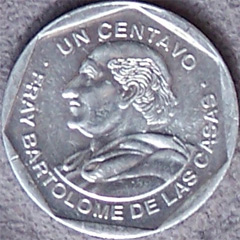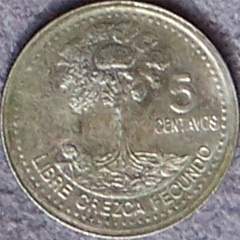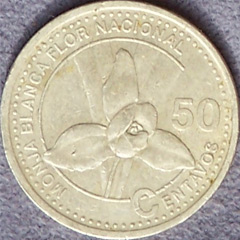
TAILS.

All of the coins feature basically the same thing on the tails side. It's the coat of arms. It consists of two bayonette rifles crossed and two sword crossed representing the fight for independence, the declaration of independence 15 Sept, 1821, and the quetzal (national bird). They have a lifesize coat of arms in the national palace in Guatemala City that I've seen several times. I've never been in the country on Independence Day (arrived 23rd Sept, then we were in eastern Canada late August until the 16th of Sept last year. I've neither seen a living quetzal, though I've walked through the quetzal reserve 30 minutes away.

HEADS.

One cent. This is Fray Bartolomé de las Casas. He's the Spanish monk who defended the Mayans against atrocity and wrote several books about them 450 years ago. From what I've heard, he also taught them to read. There's a town 4 hours away that is named after him - it's very hot there and there are snakes.

The five cent coin says "Free Grow Fertile." Pictured is the ceiba, the national tree.

The dime carries the picture of the Quirigua Monolith, an obelisk ruin situated about 2 1/2 hours away from where I live. I haven't been yet, but when I head up that road, I'll stop for a visit. Apparently the ruins are pretty cool there too.

I don't know who this is on the quarter, but I think it's just one of the indigenous people of Guatemala to recognize them.

The monja blanca (white nun) is on the half-quetzal. It's the national flower, but it's actually an orchid. It's also the name of a bus line here, and a heap of restaurants, stores, and other touristy stuff. It's against the law to pick or sell them, but I've been offered them quite a few times. They ask Q100 ($15), but what am I going to do with a white nun?

The Quetzal coin commemorates the signing of the peace accord between the army and the guerillas on December 29, 1996. This marked the end of a 36-year civil war in which more than 200,000 people (mostly civilians) were killed (93% of the killing was done by the army). Across the top of the coin is says "Peace, firm and lasting." The word Paz (meaning Peace) is written again in the shape of a quetzal.
| Guatemalan Centavos | Canadian Cents |
| 1 | 0.16¢ |
| 5 | 0.78¢ |
| 10 | 1.56¢ |
| 25 | 3.89¢ |
| 50 | 7.78¢ |
| 100 or Q1 | 15.56¢ |
The Quetzal was on par with the $US until 1987. Something happened. What?



3 comments:
I like your paper money better than your coins. Elvis is on your paper money. No white nun can beat that - unless she's Mother Teresa.
I like looking at coins and money from other countries. The US money is sooooo boring compared to the rest of the world. I like our Canadian money. Very colourful.
Currency: Guatemala Quetzal
Begins: May 1925
Sources: Franz Pick, Pick's Currency Yearbook, New York: Pick's World Currency Report (1951-1995) and Franz Pick and Rene Sedillot, All the Monies of the World, New York: Pick Publishing Corp., 1971; League of Nations, Monthly Statistical Bulletin, Geneva: League of Nations (1920-1946); Commercial and Financial Chronicle (1920-1970); Uffici di Cambi, Italy (1970-); Financial Times (1990-); Banco de Guatemala web site
Notes: The Guatemala Peso was linked to the French coin of 5 Francs in 1870; however, convertibility was suspended in 1895 and a steady depreciation followed. The Quetzal replaced the Peso on May 7, 1925, linking the Quetzal to the U.S. Dollar at par. In 1984 a triple exchange rate market was introduced which lasted until 1988.
In the first market (Official) the exchange rate was pegged to the U.S. dollar, the intervention currency, at par. In the second market (Interbank) the exchange rate was fixed on the basis of supply and demand. In the third market (Auction), the exchange rate could be administered by the central bank. The official exchange rate was applied to all government transactions and to incomes from exports of petroleum, coffee, cotton, and to payments for essential imports. All other transactions used to the interbank exchange rate. In June 1988 the triple market was unified into one exchange rate market where the quetzal was exchanged around a parity of 22.70 against the U.S. dollar. This unification marked to end of reform that had begun in 1986. In November 1989 the managed exchange rate was replaced by a system of free float where interventions by the central bank were limited to keeping order in the market. In 1990 the exchange rate system changed many times from a free system to a managed system. From March 1994 the quetzal exchange rate on the interbank market has been fixed according to market quotations.
jejej scus me isn´t Elvis in Q20 is Dr. Mariano Galves one of the most brilliant and prominent jurist of his time in Guatemala striking loserrr!!!! ignorant!!!
Post a Comment